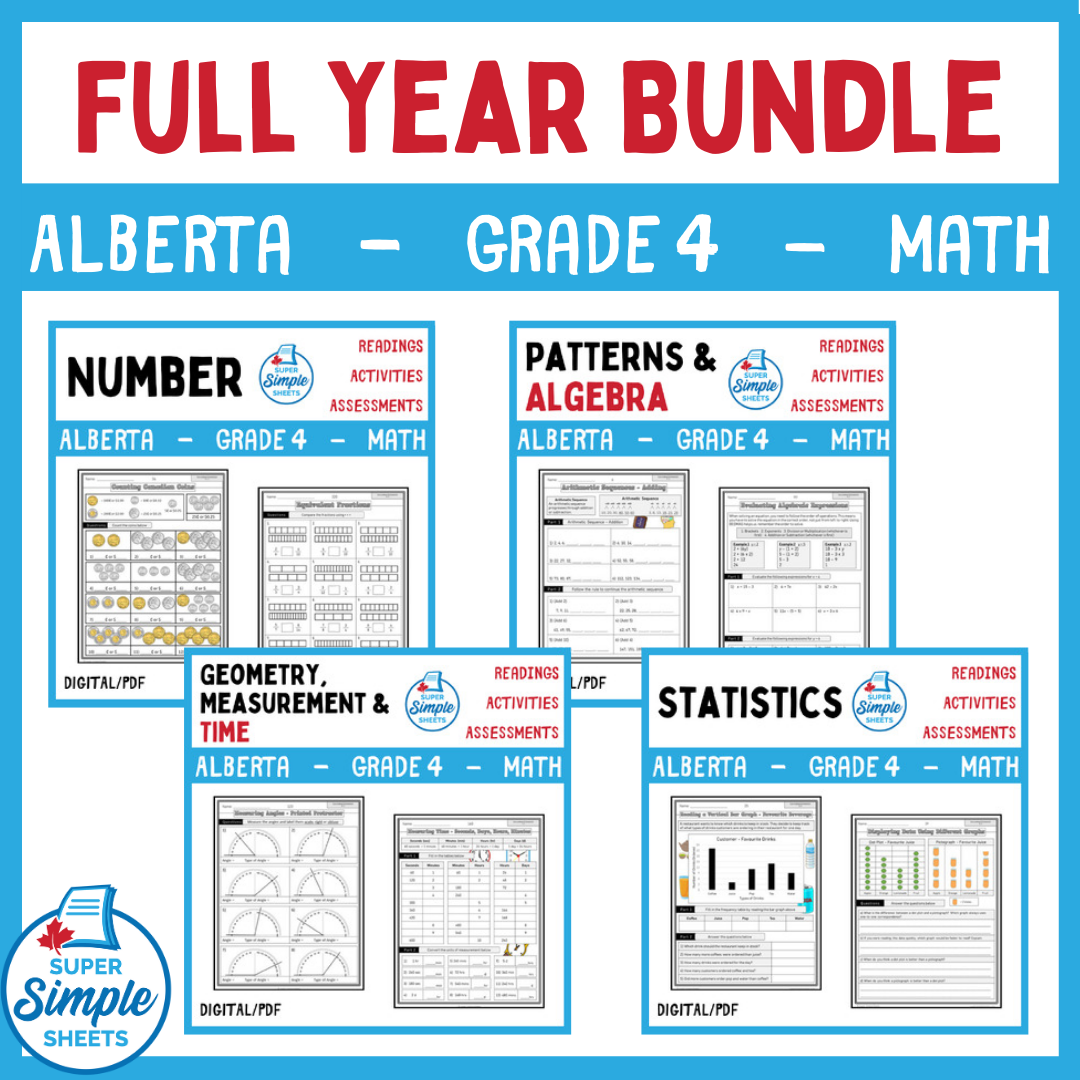Grade 4 - Alberta Math - Full Year Bundle NEW 2022 Curriculum
Grade 4 - Alberta Math - Full Year Bundle NEW 2022 Curriculum
Interested in a bundle? Shop below instead!
Couldn't load pickup availability
PRODUCT PREVIEW
UPDATED FOR THE NEW 2022 CURRICULUM! PDF AND GOOGLE SLIDES INCLUDED!
Grade 4 - Alberta Math Curriculum – This resource covers all outcomes in the Grade 4 - Alberta Math Curriculum.
Check out each of the strands below to learn more about the resources included in this bundle.
Strand 1 - Number (Number Sense)
Concepts that are covered:
- Place value within 100 000
- Place value of decimal numbers, including tenths and hundredths
- Express numbers, including decimal numbers, using words and numerals
- Expanded form of natural numbers and decimal numbers
- Decimal notation in English and French
- Rounding numbers, including to the nearest tenth
- Compare and order numbers, including decimal numbers
- Compare cents (decimal numbers) to dollars (whole numbers)
- Add and subtract numbers within 10 000
- Add and subtract decimal numbers to hundredths
- Assess the reasonableness of a sum or difference using estimation
- Adding and subtracting money amounts (decimal numbers)
- Determining factors of a number within 100
- Describe a number as prime or composite
- Determine the first five multiples of a given number within 100
- Recognize the greatest common factor of two numbers within 100
- Multiplication and division facts using numbers to 12
- Patterns in multiplying and dividing by 10, 100, 1000
- Multiply and divide 3-digit natural numbers by 1-digit natural numbers using standard algorithms
- Divide and express a quotient with or without a remainder
- Investigate strategies for estimation of products and quotients
- Assess the reasonableness of a product or quotient using estimation
- Model equivalent fractions by partitioning a whole
- Compare and order fractions
- Simplify fractions
- Relate fractions to decimals
- Compare percentages within 100
- Express relationship between fractions, decimals, and percent
- 4 Unit tests
- Answer pages for all activities
Strand 2 - Patterns and Algebra
Some of the concepts that are covered:
- Fibonacci sequence (patterns)
- Increasing and decreasing sequences (patterns)
- Creating increasing and decreasing sequences
- Representing a concrete or pictorial sequence using numbers
- Table of values
- Arithmetic sequences – addition and subtraction
- Geometric sequences – multiplication
- Describing a sequence using a pattern rule
- Initial value of a pattern and constant change
- Determining the missing value in different sequences using all operations
- What are equations?
- What are expressions? Differences between equations and expressions
- Evaluating expressions
- Creating multiple expressions that represent the same number
- Writing equations that represent a situation
- Writing expressions that represent a situation
- Preservation of equality
- Finding the unknown number in an equation
- Solving word problems using equations to represent the problem
- 2 Unit Tests
- Answer pages for all activities
Strand 3 - Geometry, Measurement and Time
Some of the concepts that are covered:
- Polygons
- Parallel and perpendicular lines in polygons
- Angles in polygons
- Measuring acute, obtuse, and right angles
- Constructing acute, obtuse, and right angles
- Estimating angles based on referents
- Acute, obtuse, and right triangles
- Scalene, isosceles, and equilateral triangles
- Supplementary and complementary angles
- Quadrilaterals – squares, rectangles, parallelograms, trapezoids, and rhombuses
- Transformations – rotations, reflections, and translations
- Modelling area by superimposing shapes
- Determining area of Indigenous (First Nations, Métis, or Inuit) designs
- Measuring area using non-standard units
- Measuring area using standard units – square centimetres
- Estimating area using referents
- Calculating area using multiplication
- Measuring angles using a protractor
- Relate angles to fractions
- Relate durations of 15 minutes, 20 minutes, 30 minutes, 40 minutes, and 45 minutes to fractions of a circle
- Express time of day using fractions – quarter to, quarter after, half past
- Determine elapsed time (duration) of an event
- Convert between hours, minutes, and seconds
- Solve word problems involving duration
- 4 Unit Tests
- Answer pages for all activities
Strand 4 - Statistics
Some of the concepts that are covered:
- What is a statistical question?
- Creating statistical questions to investigate
- The statistical problem-solving process
- What the scale of a graph is
- How to determine an appropriate scale
- Reading different graphs with the same data but different scales
- The effects scale has on graphs
- When to use each type of graph – dot plot, bar graph, pictograph
- The same data represented in each of the different graphs – dot plot, bar graph, pictograph
- Interpret data in different types of graphs
- Complete the statistical problem-solving process
- Create a statistical question, collect data, represent the data using an appropriate graph, and interpret the data
- Unit test
- Answer pages for all activities
*ANSWER PAGES INCLUDED*
This is a comprehensive bundle that will save you hours of planning! It has been tested and found effective in helping students achieve the learning goals setup by Alberta Education.
Share

Love using theses in my class




